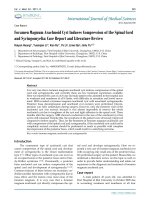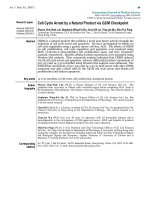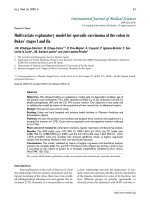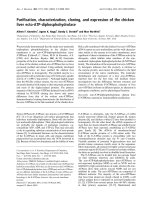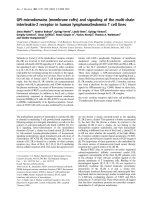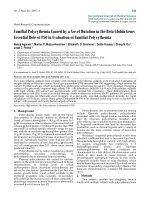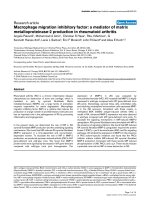Báo cáo y học: "Spontaneous Hemoperitoneum Caused By a Diverticulum of the Sigmoid Colon"
Bạn đang xem bản rút gọn của tài liệu. Xem và tải ngay bản đầy đủ của tài liệu tại đây (283.59 KB, 3 trang )
Int. J. Med. Sci. 2011, 8
467
I
I
n
n
t
t
e
e
r
r
n
n
a
a
t
t
i
i
o
o
n
n
a
a
l
l
J
J
o
o
u
u
r
r
n
n
a
a
l
l
o
o
f
f
M
M
e
e
d
d
i
i
c
c
a
a
l
l
S
S
c
c
i
i
e
e
n
n
c
c
e
e
s
s
2011; 8(6):467-469
Case Report
Spontaneous Hemoperitoneum Caused By a Diverticulum of the Sigmoid
Colon
Bong Hyeon Kye
1
, Hyung Jin Kim
1
, Joo Hee Yoon
2
, Dong Choon Park
2
, and Sung Jong Lee
2
1. Department of Surgery, College of Medicine, The Catholic University of Korea, Seoul, Korea
2. Department of Obstetrics and Gynecology, College of Medicine, The Catholic University of Korea, Seoul, Korea
Corresponding author: Sung Jong Lee, Department of Obstetrics & Gynecology, St. Vincent’s Hospital, 93-6 Ji-dong,
Paldal-gu, Suwon, Kyeonggi 442-723, Korea. Tel: 82-31-249-7300; Fax: 82-31-254-7481; E-mail:
© Ivyspring International Publisher. This is an open-access article distributed under the terms of the Creative Commons License (
licenses/by-nc-nd/3.0/). Reproduction is permitted for personal, noncommercial use, providefd that the article is in whole, unmodified, and properly cited.
Received: 2011.05.04; Accepted: 2011.07.25; Published: 2011.08.03
Abstract
The diverticulum of the sigmoid colon is relatively common in the gastrointestinal tract,
with the majority of cases being asymptomatic. A non-traumatic hemoperitoneum sec-
ondary to colonic diverticulum is very rare. Here, we report the case of a 35-year-old
woman with hemoperitoneum caused by the bleeding of the serosal vessel of the sigmoid
colon diverticulum. The bleeding focus was identified and ligated, and the diverticulum
was invaginated laparoscopically. No blood vessel malformation was detected.
Key words: hemoperitoneum; diverticulum; sigmoid colon; bleeding
Introduction
A colonic diverticulum, which is associated with
aging and low-fiber diet, is the most common disease
in Western countries [1]. The causes include changes
in colon wall resistance [2] and colon motility [3]. In
most cases, it is asymptomatic, but major complica-
tions could include diverticulitis and intraluminal
hemorrhage [4, 5].
Interestingly, intraperitoneal hemorrhage of a
colonic diverticulum is extremely rare, but very fatal.
Herein, we report a case of colonic diverticulum that
manifested as hemoperitoneum.
Case report
A 35-year-old woman presented with a 24-hour
history of left lower-quadrant abdominal pain. She
underwent tubal ligation for contraception when she
was 30 years old, and there were no signs of trauma.
She had no history of ectopic pregnancy or any he-
matologic disorder and did not receive an-
ti-coagulation treatment.
She was hemodynamically stable. Her hemoglo-
bin level was 13.1 g/dL, and the white blood cell
count was 5.9 × 10
9
/L. A coagulation test conducted
showed normal results. Urinary pregnancy test was
negative, and computer tomography scan showed
fluid collection and cyst formation in the left ovary
(Fig. 1). Culdocentesis confirmed hemoperitoneum.
On the basis of her clinical manifestations, hemoperi-
toneum secondary to the ovarian cyst rupture was
suspected, and laparoscopic surgery was planned.
During laparoscopy, more than 500 ml of blood and
blood clots were evacuated. A 2-cm large left ovary
cyst was noted, but there was no bleeding in both the
ovaries and fallopian tubes. Hematoma in the omen-
tum was noted, but there was no omental bleeding.
On examining the sigmoid colon, a diverticulum, 10 ×
2 × 1 mm in size was found, and the bleeding focus
was identified in the proximal part of the sigmoid
colon (Fig. 2). No evidence of intraluminal bleeding
was noted; however, the diverticulum site could not
be clearly examined during intraoperative colonos-
Ivyspring
International Publisher
Int. J. Med. Sci. 2011, 8
468
copy owing to incomplete bowel preparation. The
bleeding was controlled by #3-0 Vycryl intracorporeal
suture, and the invagination of the diverticulum was
performed laparoscopically. The recovery was une-
ventful, and the patient was discharged on postoper-
ative day 4.
Fig.1 Fluid collection and left ovary cyst was noted on
computed tomography. The size of ovary cyst was 2.0 × 1.8
cm (arrow).
Fig. 2 Spontaneous diverticular bleeding of the sigmoid
colon (arrow).
Discussion
The prevalence of diverticulum in patients aged
65 years or more is as high as 65%, but merely 5% in
those below 40 years of age [6].
Sigmoid colon diverticulum is closely associated
with high luminal pressure and weak bowel wall,
which create pulsion diverticula on the sigmoid colon
[7]. First, the colon consists of a monolayer of inner
circular muscle, which makes its wall weak, as com-
pared to the small intestine that is formed of the inner
circular and outer longitudinal muscle layers. The
vasa recta, which supply the mucosa and submucosa
of the colon, penetrate the circular muscle. The
weakness of the vascular portals in the circular muscle
possibly causes mucosal herniation into the subserosa
[8]. Second, the small diameter of the sigmoid colon
causes a high intraluminal pressure. A low-fiber diet,
colon segmentation, long transit time of small stool
volume, and abundant innervations of the cholinergic
nerve all contribute to the high intraluminal pressure
[1, 9-11].
Thus far, only 1 case of hemoperitoneum result-
ing from colonic diverticulum has been reported [12].
The cause of hemoperitoneum in that case was the
hypertensive change [12], while in our case, the
spontaneous bleeding of the serosal vessel of the co-
lonic diverticulum led to hemoperitoneum.
Laparoscopic resection of Meckel’s diverticulum
was successfully performed in an emergency condi-
tion [13]. In addition, laparoscopy has fewer postop-
erative complications than conventional laparotomy
in sigmoid colon resection performed for diverticu-
lum [14]. Invagination and diverticulectomy have
been performed to treat diverticula to preserve the
blood supply to the intestine. In the present case,
blood supply to the intestine had to be preserved be-
cause the patient had hemoperitoneum. In addition,
the remaining colon wall was normal, but the bowel
preparation was poor. The invagination of diverticu-
lum has an advantage over diverticulectomy in that it
minimizes bowel leakage [15]. Moreover, invagina-
tion of diverticulum can be easily performed using
laparoscopy with a simple suture technique. There-
fore, we decided to invaginate the diverticulum in-
stead of using diverticulectomy.
We reported a case of colonic diverticulum that
was successfully treated by laparoscopic suture and
invagination of the diverticulum. Our case highlights
the occurrence of hemoperitoneum as the complica-
tion of colonic diverticulum.
Int. J. Med. Sci. 2011, 8
469
Conflict of Interest
The authors have declared that no conflict of in-
terest exists.
References
1. Burkitt DP, Walker AR, Painter NS. Effect of dietary fibre on
stools and the transit-times, and its role in the causation of
disease. Lancet. 1972;2:1408-12.
2. Stumpf M, Cao W, Klinge U, Klosterhalfen B, Kasperk R,
Schumpelick V. Increased distribution of collagen type III and
reduced expression of matrix metalloproteinase 1 in patients
with diverticular disease. Int J Colorectal Dis. 2001;16:271-5.
3. Cortesini C, Pantalone D. Usefulness of colonic motility study
in identifying patients at risk for complicated diverticular
disease. Dis Colon Rectum. 1991;34:339-42.
4. Kourtesis GJ, Williams RA, Wilson SE. Surgical options in acute
diverticulitis: value of sigmoid resection in dealing with the
septic focus. Aust N Z J Surg. 1988;58:955-9.
5. Peura DA, Lanza FL, Gostout CJ, Foutch PG. The American
College of Gastroenterology Bleeding Registry: preliminary
findings. Am J Gastroenterol. 1997;92:924-8.
6. Parks TG. Natural history of diverticular disease of the colon.
Clin Gastroenterol. 1975;4:53-69.
7. West BA. The pathology of diverticulosis: classical concepts
and mucosal changes in diverticula. J Clin Gastroenterol.
2006;40 (Suppl 3):S126-31.
8. Ye H, Losada M, West AB. Diverticulosis coli: update on a
"Western" disease. Adv Anat Pathol. 2005;12:74-80.
9. Tomita R, Fujisaki S, Tanjoh K, Fukuzawa M. Role of nitric
oxide in the left-sided colon of patients with diverticular
disease. Hepatogastroenterology. 2000;47:692-6.
10. Painter NS, Truelove SC. The intraluminal pressure patterns in
diverticulosis of the colon. I. Resting patterns of pressure. II.
The effect of morphine. Gut. 1964;5:201-13.
11. Painter NS, Truelove SC, Ardran GM, Tuckey M. Segmentation
and the localization of intraluminal pressure in the human
colon, with special reference to the pathogenesis of colonic
diverticula. Gastroenterology. 1968;54(Suppl):778-80.
12. Lawson HH. Haemoperitoneum associated with a solitary
diverticulum of the sigmoid colon. S Afr Med J. 1961;35:715-6.
13. Matsagas MI, Fatouros M, Koulouras B, Giannoukas AD.
Incidence, complications, and management of Meckel's
diverticulum. Arch Surg. 1995;130:143-6.
14. Siddiqui MR, Sajid MS, Qureshi S, Cheek E, Baig MK. Elective
laparoscopic sigmoid resection for diverticular disease has
fewer complications than conventional surgery: a
meta-analysis. Am J Surg. 2010;200:144-61.
15. Cullen JJ, Kelly KA, Moir CR, Hodge DO, Zinsmeister AR,
Melton LJ3
rd
. Surgical management of Meckel's diverticulum.
An epidemiologic, population-based study. Ann Surg.
1994;220:564-8.

